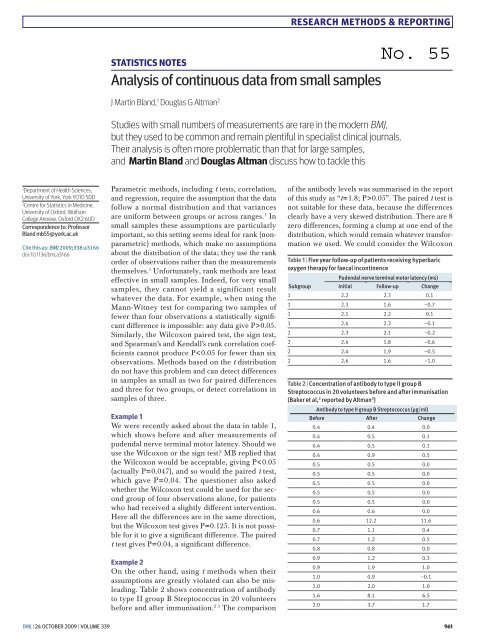BMJ Statistical Notes Series List by JM Bland: http://www-users.york ...
BMJ Statistical Notes Series List by JM Bland: http://www-users.york ...
BMJ Statistical Notes Series List by JM Bland: http://www-users.york ...
Create successful ePaper yourself
Turn your PDF publications into a flip-book with our unique Google optimized e-Paper software.
1 Department of Health Sciences,<br />
University of York, York YO10 5DD<br />
2 Centre for Statistics in Medicine,<br />
University of Oxford, Wolfson<br />
College Annexe, Oxford OX2 6UD<br />
correspondence to: Professor<br />
<strong>Bland</strong> mb55@<strong>york</strong>.ac.uk<br />
Cite this as: <strong>BMJ</strong> 2009;338:a3166<br />
doi: 10.1136/bmj.a3166<br />
Parametric methods, including t tests, correlation,<br />
and regression, require the assumption that the data<br />
follow a normal distribution and that variances<br />
are uniform between groups or across ranges. 1 In<br />
small samples these assumptions are particularly<br />
important, so this setting seems ideal for rank (nonparametric)<br />
methods, which make no assumptions<br />
about the distribution of the data; they use the rank<br />
order of observations rather than the measurements<br />
themselves. 1 Unfortunately, rank methods are least<br />
effective in small samples. Indeed, for very small<br />
samples, they cannot yield a significant result<br />
whatever the data. For example, when using the<br />
Mann-Witney test for comparing two samples of<br />
fewer than four observations a statistically significant<br />
difference is impossible: any data give P>0.05.<br />
Similarly, the Wilcoxon paired test, the sign test,<br />
and Spearman’s and Kendall’s rank correlation coefficients<br />
cannot produce P
















